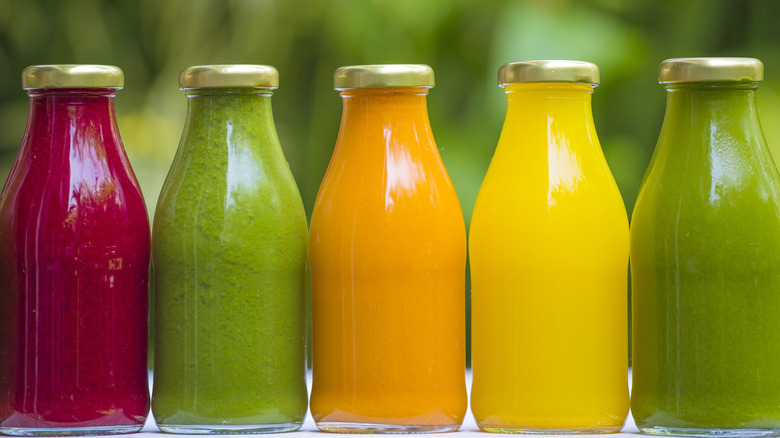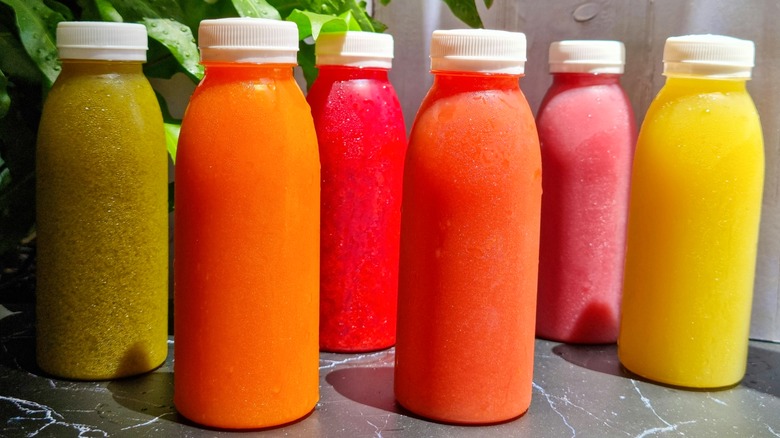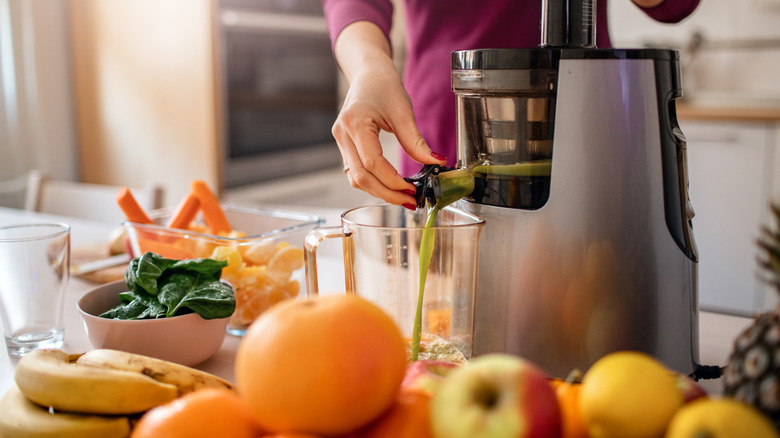What Cold-Pressed Really Means For Juices
A glass of cold, freshly-squeezed juice is a refreshing, hydrating, and vitamin-packed way to start the day. But, beyond choosing which fruits, vegetables, or a combination of both to go for, there are other questions that face shoppers when picking up a bottle or carton at the store. Not-from-concentrate, organic, raw, all-natural, and 100% juice are just some of the terms seen on fresh juice labels. Cold-pressed juice is another description that has grown in popularity. But what does it actually mean?
There are essentially two main methods for juicing: centrifugal and cold press. Centrifugal juicers, which are the type we're more likely to use in our home kitchens, use a blade, which spins quickly to chop up fruit and vegetables, breaking them down. This process also generates some heat. Fruits and vegetables can be thrown in whole, without needing to be chopped first, and filters (made from a fine mesh) separate the juice from the pulp.
Cold-press juicers, which are also sometimes referred to as slow press or masticating juicers, do not have a blade. Instead, they have a mechanism called an auger that slowly crushes and presses the produce, which needs to be chopped first in order to extract the juice.
Why is cold-pressed juice more expensive?
Cold-pressed juices tend to come with a larger price tag, and there are a number of reasons they cost more, starting with the fact that cold-press juicing machines tend to be more expensive to buy than centrifugal juicers — whether they're for commercial or home use.
Another reason that cold press juice costs more is that it takes a longer time to actually make it. The juicing process is slower with the cold-press method, and the fruit or vegetables also need to be chopped first before they go into the hydraulic press. The produce is then squeezed slowly, under a huge amount of pressure, in order to obtain as much of the juice as possible. These machines may extract a greater amount of juice, but the process is more time-consuming, which means the labor costs involved are also greater.
Additionally, it takes more fresh fruit or vegetables to make a bottle of cold-pressed juice than it does using a centrifugal press. And the cost of that extra fresh produce means a higher price point for the consumer.
What are the benefits of cold-pressed juices?
The first difference you'll tend to notice with a cold-pressed juice is how it actually looks. The juice tends to be thicker, with less foam and separation than when using a centrifugal press, and it may have a brighter color, too.
Cold-pressed juices can also handle leafy greens such as kale or spinach better than centrifugal juices, with less waste. So if you're looking for that green juice high, a cold press is the way forward. If you're juicing at home, you may also find there is less waste from fruit such as berries when using a cold press. In the store or juice bar, these benefits can mean you'll find a greater variety of drinks to choose from as well.
Cold-pressed juices tend to stay fresher for longer than those made with a centrifugal press, too, with some arguing that the former also retains more vitamins and nutrients over a longer period, although some studies dispute this claim. But, with a global market expected to grow to a whopping $1.86 billion by 2029 (via Fortune Business Insights,) it seems we can't get enough of cold-pressed juices, and that trend is only likely to keep on growing.



